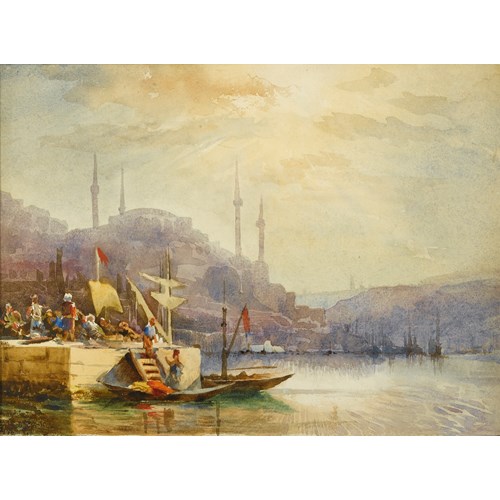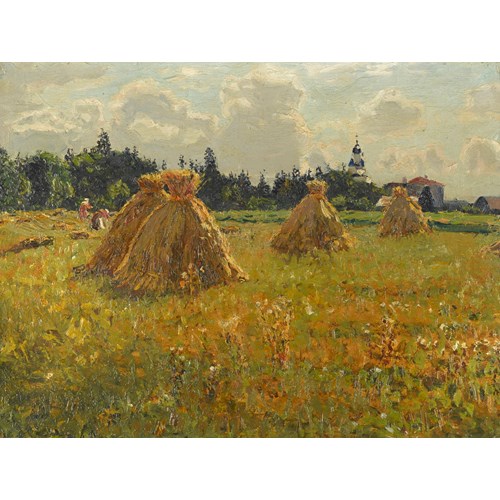Domenico Tintoretto
Portrait of Paolo Tiepolo (1523 - 1585)
Date 1590
Period 1400-1600, 16th Century
Origin Italy
Medium Oil on canvas
Dimension 45.5 x 40.4 cm (17⁷/₈ x 15⁷/₈ inches)
The circumstances surrounding the execution of the present work have recently been explored by Dr. Roland Krischel, who believes it to be a copy by Domenico Tintoretto, after an earlier version by Domenico’s father Jacopo Tintoretto (1519-1594).¹ Dr. Krischel dates the Cologne version to the 1570s, when Tiepolo was at the height of his career.² It is plausible that the present work is a modello, painted by Jacopo as part of the development for the larger portrait. However, an examination of the Cologne portrait under infrared light, has led Krischel to believe that the smaller work must have been painted later.³ This is because the irises of the Cologne portrait were originally centred, before being moved to the corners of the eyes, in the manner of the smaller work. Krischel argues that if the present work were a modello, surely therefore the irises in that painting would also be in the original, central position.
Instead it seems likely that the present work was painted in 1590. In that year a large-scale refurbishment of the Procuratie in St. Mark’s Square took place, and during the reconstruction many of the portraits of the Procurators that hung there, including the Cologne work, were temporarily housed in the Tintoretto studio. It was during this period that Krischel argues the present work was painted by Domenico, taking advantage of the chance to study his father’s twenty-year old version.
There are a further two notable depictions of Tiepolo, executed posthumously during the 1590s, which probably used the present work as their source. In 1592 Giulio del Moro sculpted a bust of Tiepolo, to be placed on the exterior of the Palazzo del Consiglio in Belluno. The physiognomy of this bust is remarkably close to that of the two Tintoretto portraits, and as the subject had died six years previously, it seems del Moro must have used one of the two paintings as his model. For reasons of practicality we can discount the larger and more unwieldy Cologne picture. Similarly Andrea Vicentino’s famous depiction of King Henri III (1551-89) of France visiting Venice in 1574, escorted by Doge Alvise Mocenigo (1570-77) and met by the Patriarch Giovanni Trevisan, features a prominent posthumous depiction of Tiepolo, which again seems to be based upon the present work.
The Tiepolos were amongst the oldest and most venerable of Venetian families. Amongst his ancestors Paolo could count numerous procurators, diplomats, governors, generals and church dignitaries, in addition to two Doges: Jacopo Tiepolo, who served from 1229 – 1249, before abdicating, and Lorenzo Tiepolo, who served from 1268 until his death in 1275. Paolo was born on the 22nd March 1523, the eldest son of Stefano Tiepolo and Cecilia di Bernardo di Pietro Priuli. Stefano himself had a highly successful political career from a very young age. He had particular expertise in maritime matters and a nautical guide was dedicated to him in 1553.⁴ In 1556 he was nearly elected Doge, but lost to Lorenzo Priuli after a bitterly fought campaign.⁵ Incidentally Stefano was also painted by Jacopo Tintoretto, featuring prominently his Excommunication of Frederick Barbarossa by Pope III, which was formerly in the Ducal Palace, but was destroyed in the fire of 1577.
As successful as Stefano was, his career rather pales in comparison to his son Paolo’s. He married Angela di Lorenzo Pasqualigio in 1547, with whom he had three children. Angela is thought to have died in childbirth, and Paolo married again in 1563. However, little else is known about his private life, particularly in comparison to the wealth of information documenting his phenomenal achievements in the public sphere.⁶ Like his father, Paolo started his career as a Savi agli Ordini, a body who administered Venice’s maritime matters and her fleet. In 1549, he started his long and distinguished ambassadorial career, representing Venice at the Mantuan court. In the years that followed he took up increasingly important ambassadorial posts, with Henry II of France (1519-1559) in 1553, Ferdinand I, the Holy Roman Emperor (1503-1564) in 1554, Phillip II of Spain (1527-1598) in 1558, and both Popes Pius IV (1499-1565) and V (1504-1572), from 1565.⁷
On his return from the Vatican in 1569, Tiepolo was elected as one of the Tre Savii Sopra l’ Eresia (the ‘three sages over heresy), a role that was generally reserved for men of the highest seniority and experience. Indeed the average age of these men was sixty-one, but Tiepolo was just forty-six. In the following years he was elected to the Great Council, the Council of Ten and the Zonta, in addition to several other posts. The amount of success Tiepolo had in elections is evidence of his political weight and importance to the Venetian state.
In 1577, after the death of Alvise I Mocenigo (1507-1577), Tiepolo was nearly elected Doge, but in a close fought race he lost to Sebastiano Venier (c. 1496-1578). However, Venier died after only nine months in office, and again Tiepolo put himself forward as a candidate. This was one of the longest of dogal elections, requiring forty-five ballots before a decision was reached, with Tiepolo eventually resigning in order to end the impasse and allow Nicolò da Ponte (1491–1585) to win. Tiepolo continued to serve Venice until his death in 1585, at the age of sixty-two, bringing to an end one of the most illustrious careers in sixteenth-century Venetian politics.
As a portraitist Domenico Tintoretto excelled, taking up the mantle of his father as one of the most accomplished of Venetian painters in this genre. Portrait of an Old Man, in the collection of the Kunsthistoriches Museum, is a similar example of his bust-length works. Like Tiepolo, the subject is a procurator, but in neither work is the distinctive uniform fully worked up. This means that a lavish depiction of costume, such as the one in Tintoretto’s Portrait of Doge Marino Grimani, does not distract from the acutely observed rendering of the subject’s features. Although each figure is painted with quick flowing brush work, the likenesses are extremely detailed and individualised. By downplaying the lavish ornament of power, Tintoretto focuses attention on the dignity and authority which these men possess.
By 1590, when the present work was painted, Domenico was in essence the dominant figure in his father’s workshop. As Tom Nichols states ‘the master increasingly left the execution of paintings to his shop foreman, Domenico, having himself generated the initial compositional idea’.⁸ Although such practise was fairly typical in Venetian painting, the Tintoretto workshop was unusual in the artistic independence granted to Domenico, and the importance placed on his contribution. For example the composition of Paradise in the Ducal Palace is only loosely based on Jacopo’s ideas.⁹
In the 1590s, Domenico was perhaps at his peak as a portraitist. After the present work was painted in 1590, in 1591 the Scuola dei Mercanti in Venice ordered two large portrait groups from him. In 1592 he travelled to Ferrara to paint a portrait of Margaret of Austria, later Queen of Spain (1584-1611), and in 1595 he was in Mantua to execute a commission for Vincenzo I Gonzaga, 4th Duke of Mantua (1562-1612). Like Jacopo, he also painted many of the most important figures in Venetian society. Having worked closely alongside him for the first part of his career, after Jacopo’s death in 1595, Domenico’s style naturally began to evolve. He allowed more room for landscape and background details in his secular works, and in his later religious works he effectively communicated Counter-Reformation messages, with the naturalism popular in seventeenth-century Rome.
We are grateful to Dr. Roland Krischel, for identifying the sitter of the present work as Paolo Tiepolo, and for his research surrounding the portrait’s execution.
¹ Krischel, R, ‘Porträt eines Diplomaten: Jacopo Tintorettos Bildnis des Paolo Tiepolo’ in Sonderdruck aus dem Wallraf-Richartz-Jahrbuch (vol. LXXIII, 2012), pp. 107-158.
² Ibid., p. 114.
³ Ibid. p.135.
⁴ Pietro da Medina, L’Arte del Navegar... (Venice 1553).
⁵ Da Mosto, A, I Dogi di Venezi nella VitaPubblica e Privata (Milan, 1966), p.324, note 84.
⁶ For a full account of Tiepolo’s life see Krischel, pp.123-132.
⁷ The depiction of the Castel Sant’Angelo in the background of the Cologne work is presumably a reference to Tiepolo’s time in Rome.
⁸ Nichols, T., Tintoretto: Tradition and Identity, (London, 1999), p.105.
⁹ Ibid. p. 106.
Date: 1590
Period: 1400-1600, 16th Century
Origin: Italy
Medium: Oil on canvas
Dimension: 45.5 x 40.4 cm (17⁷/₈ x 15⁷/₈ inches)
Literature: Roland Krischel, 'Porträt eines Diplomaten: Jacopo Tintorettos Bildnis des Paolo Tiepolo' in Sonderdruck aus dem Wallraf-Richartz-Jahrbuch, vol. LXXIII, 2012, pp.135-136, illustrated fig. 15.
Exhibition: The Venetian Diplomat - Tintoretto’s portrait of Paolo Tiepolo, Wallraf-Richartz-Museum, Cologne, 3rd May - 15th September 2013.
More artworks from the Gallery


_T638989902574827885.jpg?width=2000&height=2000&mode=max&scale=both&qlt=90)





 The Harvest_T638810975891048810.jpg?width=500&height=500&mode=pad&scale=both&qlt=90&format=jpg)
